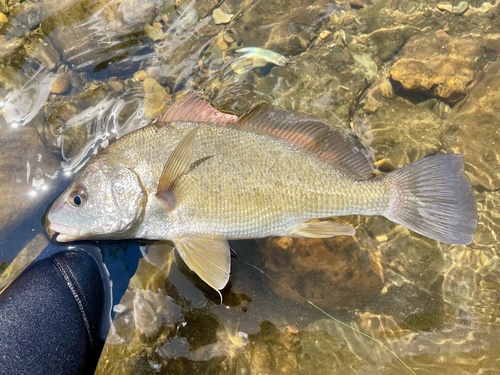
Freshwater Drum
The Bluefin Tuna (Thunnus thynnus, Thunnus orientalis, Thunnus maccoyii) is a group of highly migratory, large pelagic fish species known for their incredible swimming speed, size, and commercial value. They are a vital part of marine ecosystems and play a crucial role in the food chain.
6 13 years
Lifespan
40 - 70 cm
Length
Least Concern
Conservation Status
15 km/h
Swimming speed
Omnivorous
Diet
Local Migration
Migration
Appearance Overview
The Bluefin Tuna is renowned for its large, streamlined body, built for speed and endurance in the open ocean.
Color
Dark metallic blue on top with a silvery-white underside
Fins
Two dorsal fins, the first depressible; small, yellow finlets run down the back and belly
Body Shape
Torpedo-shaped, designed for efficient swimming
Length
Up to 13 feet (4 meters), commonly 6.5 feet (2 meters)
Weight
Up to 2,000 lbs (907 kg), commonly around 550 lbs (250 kg)
Diet
Carnivorous, feeding on a variety of fish, squid, crustaceans, and occasionally on seaweed and other marine plants.
Feeding Behavior
Highly active predator, using its speed and agility to hunt. They can dive to considerable depths to find food.
Social Behavior
Forms large schools, especially during migration and spawning. However, they can also be found foraging alone.
Commercial Relevance
Extremely high value, especially in sushi and sashimi markets, where its fatty flesh is considered a delicacy.
Conservation measures
International fishing quotas, catch limits, minimum size restrictions, and efforts to monitor and manage populations by organizations like ICCAT.
Status
Varies by species: Atlantic Bluefin Tuna (Endangered), Pacific Bluefin Tuna (Vulnerable), Southern Bluefin Tuna (Critically Endangered)
Threats
Overfishing driven by high demand in the seafood market, bycatch in other fisheries, and habitat degradation.
Habitat Distribution
Depth Range
0-3,300 feet (0-1,000 meters), though they are most commonly found in the upper few hundred feet.
Geographic Range
Atlantic Ocean (from Newfoundland to the Mediterranean Sea), Pacific Ocean (from Japan to California), and Southern Ocean (around Australia, New Zealand, and South Africa).
Preferred Environment
Temperate and subtropical waters, often in the open ocean but also in coastal areas during spawning.
Reproduction and Life Cycle
Breeding Habits
Spawns in specific areas, such as the Gulf of Mexico and the Mediterranean Sea for Atlantic Bluefin Tuna. Spawning typically occurs in warm waters during specific seasons.
Development Stages
Eggs hatch into larvae, which drift with the currents. Juveniles grow rapidly, feeding and developing in nutrient-rich waters before becoming apex predators.
Fecundity
Females are highly fecund, capable of releasing millions of eggs (up to 30 million) per spawning season.
Maturity Age
Varies by species; Atlantic Bluefin Tuna typically mature at 4-8 years, while Southern Bluefin Tuna mature later, at around 8-12 years.
Faqs about Freshwater Drum
How fast can Bluefin Tuna swim?
Bluefin tuna are among the fastest fish in the ocean, capable of bursts of speed up to 43 mph (70 km/h).
What is the lifespan of a Bluefin Tuna?
They can live up to 40 years, though the average lifespan is closer to 15-25 years.
Are Bluefin Tuna warm-blooded?
Yes, they are warm-blooded, which is unusual for fish. They have a special circulatory system that conserves heat.
How do Bluefin Tuna regulate their body temperature?
Bluefin tuna have a unique ability to maintain their body temperature higher than the surrounding water, which helps them survive in a wide range of temperatures.
Do Bluefin Tuna migrate?
Bluefin tuna undertake long migrations across oceans for feeding and breeding, traveling thousands of miles each year.
Where are Bluefin Tuna found?
They are found in the Atlantic, Pacific, and Indian Oceans, as well as the Mediterranean Sea.
Why are Bluefin Tuna populations threatened?
The high demand for bluefin tuna in sushi and sashimi markets, combined with their slow growth and late maturity, makes them particularly vulnerable to overfishing.
What organizations manage Bluefin Tuna fisheries?
International organizations like the International Commission for the Conservation of Atlantic Tunas (ICCAT) play a key role in managing bluefin tuna fisheries.
How can consumers help Bluefin Tuna conservation?
Consumers can support sustainable bluefin tuna populations by choosing sustainably sourced seafood and avoiding consumption of threatened bluefin tuna species.
Why are Bluefin Tuna important to the marine ecosystem?
Bluefin tuna are apex predators that help regulate the populations of their prey, contributing to the balance of marine ecosystems.
Copyright @ Nature Style Limited. All Rights Reserved.
 English
English